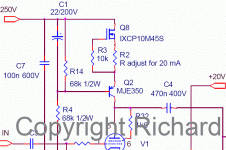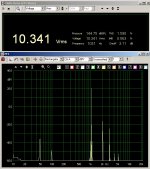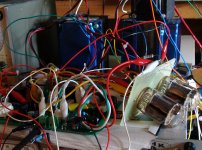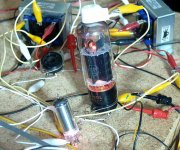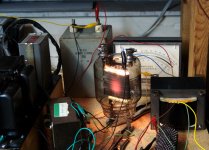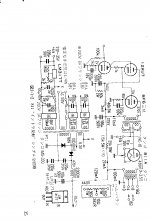wrenchone said:Kenpeter, The current souce as presented needs the
cascode, as the top element is a lowly 40VJFET.
I did say in the 2nd schematic of the PDF.
Q8, the IXCP10M45S is no mere 40V jfet.
You presented both drawings, and asked
for comments...
Attachments
Finally the first test result using 6HV5A to drive 845
6HV5A loaded by 20H (Rdc=70ohm) and Rk=100ohm Ck=220uF
950V 28mA
845 loades by Tango X-10S 10K/8ohm Vg=150v Rg=22Kohm
950V 100mA
10Vrms on 8ohm with 2% thd
Interstage 2.2uF // 0.33uF Audyn-Cap Plus
Very good sound
Very good voltage gain
Power can be increased using 1100V instead of 950v
Soon next test and photos
6HV5A loaded by 20H (Rdc=70ohm) and Rk=100ohm Ck=220uF
950V 28mA
845 loades by Tango X-10S 10K/8ohm Vg=150v Rg=22Kohm
950V 100mA
10Vrms on 8ohm with 2% thd
Interstage 2.2uF // 0.33uF Audyn-Cap Plus
Very good sound
Very good voltage gain
Power can be increased using 1100V instead of 950v
Soon next test and photos
Attachments
opened new forum about 6hv5a to drive 845
http://www.diyaudio.com/forums/showthread.php?s=&threadid=132552
http://www.diyaudio.com/forums/showthread.php?s=&threadid=132552
I actually ended up with a pair of 6HV5A after the Plano HAMCON.
Thought I was buying a lower voltage beam power tube, and must
have mixed the part numbers in my head... You know, the tube for
Pete Millet's Red board, that one??? Yeah, thats what I imagined
I walking away with... Not quite the same thing at all now, is it?
Anyways, no way in heck I'm foolin with 1200 standing volts + swing.
And also simply don't have output iron with that sort of impedance.
If I can use this at all, will have to be at lower voltage with a current
multiplier in parallel. Anyways, I doubt it will pass more than 50mA
at voltages I intend to use. Unless I drive into A2, which is probably
redundant abuse considering what a Triodlington can conduct in A1.
My question is: If I am not needing the full 320mA cathode emission,
can I run the cathode a bit colder? 1.8A is a lot of heater current for
for only 50mA reward. Would running the cathode at 5V damage the
cathode in any way? How long does it take to poison a cathode? At
reduced plate voltages, am I also throwing fewer damaging ions back
onto the cathode?
Thought I was buying a lower voltage beam power tube, and must
have mixed the part numbers in my head... You know, the tube for
Pete Millet's Red board, that one??? Yeah, thats what I imagined
I walking away with... Not quite the same thing at all now, is it?
Anyways, no way in heck I'm foolin with 1200 standing volts + swing.
And also simply don't have output iron with that sort of impedance.
If I can use this at all, will have to be at lower voltage with a current
multiplier in parallel. Anyways, I doubt it will pass more than 50mA
at voltages I intend to use. Unless I drive into A2, which is probably
redundant abuse considering what a Triodlington can conduct in A1.
My question is: If I am not needing the full 320mA cathode emission,
can I run the cathode a bit colder? 1.8A is a lot of heater current for
for only 50mA reward. Would running the cathode at 5V damage the
cathode in any way? How long does it take to poison a cathode? At
reduced plate voltages, am I also throwing fewer damaging ions back
onto the cathode?
Last edited:
I was thinking about running mine with positive grid voltage just like a screen driven sweep tube. That way, you can get some plate current without those godawful high plate voltages. The plate curves even look to me like a screen driven sweep. Try 600-700V plate voltage for starters. I have a fair number of 6HV5As, and they're still on my "to do" list one of these days, once I finish plucking some lower-hanging fruit. One possibility would be to use a decent triode-pentode dual in front, with the pentode as voltage amp and the triode as a follower. I doubt that one would need to drive a lot of grid current to get some plate current (at least for an SE amp), so a modest triode might do quite nicely.
I figure if I have to throw a piece of sand at it to drive up conductance,
A2 can only go so far, and maybe puts G1 at risk? Triodlington, no limits.
Obviously this is leaning heavy on sand for all except Mu, and not really
running the tube anywhere near its best operating point.
The only iron I got right now is Edcor CXPP100-MS-5K, I'd have to deal
with matching to that. Got other tubes more suitable for the blue beast,
just thought 300Mu in a single stage was maybe too cool to pass up.
A2 can only go so far, and maybe puts G1 at risk? Triodlington, no limits.
Obviously this is leaning heavy on sand for all except Mu, and not really
running the tube anywhere near its best operating point.
The only iron I got right now is Edcor CXPP100-MS-5K, I'd have to deal
with matching to that. Got other tubes more suitable for the blue beast,
just thought 300Mu in a single stage was maybe too cool to pass up.
Last edited:
In my experience, so far, I haven't had to drive my single-ended sweep amps very far into grid conduction to get decent results, and that's with grids far less sensitive than the 6HV5.I was thinking of using two pieces in parallel with a 5k transformer, as I don't like any of the readily available 10k transformers all that much. I have a pair of the large 5k "Rev1" Transcendars, that may be just the thing. Anyway, I figure you or I or George will try this when one of us gets around to it.
I went to visit Stan at ESRC last year and I physically looked at most every tube on the $1 list. I came across a big fat looking capless sweep tube that turns out to be a close relative of the 6HV5. It is the 6JD5 and is still on the dollar menu. I bought 10 just for fun.
So far my only experiment proved that unlike some of my other contraptions, you can not make a clip lead amp with these tubes. The result will wipe out TV reception!
I think I will try some in the red board next. Modifications required, not a direct plug in!
So far my only experiment proved that unlike some of my other contraptions, you can not make a clip lead amp with these tubes. The result will wipe out TV reception!
I think I will try some in the red board next. Modifications required, not a direct plug in!
Though I've tried to contact Pete and get a red board, my approach
has been about trying to arrange a meeting locally. Maybe he just
don't do that? Whatever his reasons, I've never gotten a response.
I'd be willing to spend a day of slave labor scanning books to PDF or
whatever. And its not like I got heaps of time to volunteer something
like that, as-if it were no big deal.
I got the right tubes and compactron sockets for the red board already,
just that one of the 6GV5 boxes from my Dad's old stash is marked "low".
He ain't alive anymore to ask him. And I've not yet had time to sit down
and figure how to use my 747 mutual conductance tester... I got manual,
but its DJVU, poorly scanned, and prints crazy small with big margins. No
two the same... Got to go page by page and fix up each one for printing.
As for 6HV5, might see if its any more stable when Schaded to lower Mu?
Particularly DC coupled 100% PG without voltage gain. That could be an
interesting mode of operation in A2, if you could toss some direct coupled
sand between Schade and Grid without a phase shift back to instability???
Or is it just that cliplead parasitics are driving you nuts?
Waitaminute... I got 13pin sockets. 6GT5 is 9 pin... Aw nutz!!! Is there
anything else could possibly go wrong...
has been about trying to arrange a meeting locally. Maybe he just
don't do that? Whatever his reasons, I've never gotten a response.
I'd be willing to spend a day of slave labor scanning books to PDF or
whatever. And its not like I got heaps of time to volunteer something
like that, as-if it were no big deal.
I got the right tubes and compactron sockets for the red board already,
just that one of the 6GV5 boxes from my Dad's old stash is marked "low".
He ain't alive anymore to ask him. And I've not yet had time to sit down
and figure how to use my 747 mutual conductance tester... I got manual,
but its DJVU, poorly scanned, and prints crazy small with big margins. No
two the same... Got to go page by page and fix up each one for printing.
As for 6HV5, might see if its any more stable when Schaded to lower Mu?
Particularly DC coupled 100% PG without voltage gain. That could be an
interesting mode of operation in A2, if you could toss some direct coupled
sand between Schade and Grid without a phase shift back to instability???
Or is it just that cliplead parasitics are driving you nuts?
Waitaminute... I got 13pin sockets. 6GT5 is 9 pin... Aw nutz!!! Is there
anything else could possibly go wrong...
Last edited:
It appears that the most notable difference between the 6HV5 and 6JD5 is transconductance. By 10,000.
As a chronic sufferer of DIY ADD, I got a bunch of 6JD5's while they're still cheap. They're just impressive tubes, never mind sanity. With a mu of 300 there has to be something practical for them if not for output use.
As a chronic sufferer of DIY ADD, I got a bunch of 6JD5's while they're still cheap. They're just impressive tubes, never mind sanity. With a mu of 300 there has to be something practical for them if not for output use.
Or is it just that cliplead parasitics are driving you nuts?
I have been told over and over that you can't build an amp using clip leads. I have never been one to listen very well so I did it......about a zillion times. Yes there are some tubes that you CAN'T clip lead together the 5842 / 417A is one and the 6EJ7 is another. It appears that the 6HV5 and friends are also on this list. Note that tubes with lots of transconductance seem to be clip lead unfriendly.
Note the method of construction used in these fully functional amps.
As for 6HV5, might see if its any more stable when Schaded to lower Mu? Particularly DC coupled 100% PG without voltage gain. That could be an
interesting mode of operation in A2, if you could toss some direct coupled
sand between Schade and Grid without a phase shift back to instability???
That is where I may go next. Reduce the gain AND the output impedance via local feedback to make a $1 triode sound like a $50 triode.
Waitaminute... I got 13pin sockets.
Then you really have something weird, since they should be 12 pin sockets. Others have suggested sky wiring octal or 9 pin sockets into this board, but that is too much work. There are dozens of 12 pin tubes that work in this board, many of them cheap. 6GV5's were on the dollar menu until this board came along.
Tube testers may tell you what the Gm is under rather low powered conditions. They don't tell you much about waht happens at 30 watts though.
Attachments
I agree that a 6HV5 or one of its siblings might be a natural for a partial feedback (Schade-style) amp as a way of utilizing all that excess gain. I was thinking of a modest triode-pentode pair (people can insert their faves) for the front end, with the pentode as voltage amp and the triode as cathode follower to direct drive the grid. I would look for a tube that had a medium-mu, relatively high gm triode (get out your tube manuals). The amp might end up with enough feedback, even with a Schade-style setup, to sound solid state-ish...
Hi!
Ever wondered how such a beam triode looks inside?
Check out my post about this tube with photos of the grid:
VinylSavor: Tube of the Month : The 6HV5A
Best regards
Thomas
Ever wondered how such a beam triode looks inside?
Check out my post about this tube with photos of the grid:
VinylSavor: Tube of the Month : The 6HV5A
Best regards
Thomas
- Status
- This old topic is closed. If you want to reopen this topic, contact a moderator using the "Report Post" button.
- Home
- Amplifiers
- Tubes / Valves
- 6HV5A Single Ended Amp
